This 'padal petra shivasthalam' in Rameswaram Island in the Gulf of Mannar, holds immense significance as one of India's holiest temples and dates back to the time of Ramayana. A bridge connects the island to the mainland and Rameshwaram is a significant must-visit destination for those who embark on a pilgrimage to Kasi to pay homage to one's deceased ancestors. 'Kasi Yatra' begins and ends at Rameshwaram with a final ritual of a bath in dhanushkoti and anointing Ramanathaswamy with 'Ganga' brought all the way from Kashi. It is renowned for its three-fold glories - Moorthy (deity), Sthalam (place of divinity) and Theertham (holy water).
Ramanathaswamy, the presiding deity of Rameshwaram is one of the 12 'Jyotir-lingam's and one of the four primary sacred destinations - Badrinath, Jagannath, Dwarkanath and Ramanath in the four cardinal directions that hold utmost significance. The first three are temples for Mahavishnu while Rameshwaram is dedicated to Lord Shiva. This 'jyothir lingam' is in a small sannidhi located in the eastern side of the first prakarm. Lord Rama's worship of Eeshwar gave the name 'Rameshwaram' to this island town and people from all over the country make it a point to visit Rameshwaram atleast once in their life-time.
Ramanathaswamy temple at Rameswaram is renowned for its extensive corridors and grand sculptured pillars that have garnered worldwide fame. The temple spans 865 feet from east to west and 675 feet from north to south. There are four gopurams, the tallest being the one at the east at an impressive height of 126 feet followed by the gopuram in the west which is at a height of 78 feet. The outermost prakaram is the lengthiest, measuring approximately 400 by 30 feet in length and breadth. The ceiling is at a height of 60 feet supported by 4000 pillars situated on an elevated platform. The breath-taking view of the prakaram make one wonder how these massive stones were brought from the mainland in those days.
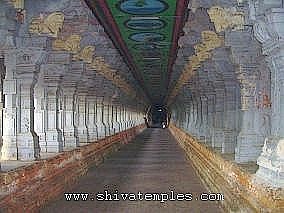
The sannidhi of the presiding deity Ramanathaswamy and His courterpart Parvathavardhini are in the innermost prakaram of the temple. Nandhi here is one of the largest at a length of 12 feet and a height of 9 feet. Within this temple, there are two Shiva Lingams, one of which is the Ramalingam that was intricately crafted out of sand by Seetha Devi. After Ravana was killed, Rama sought to absolve himself of 'Brahmahati Dosha' (the sin of killing) by worshipping Lord Shiva. He asked Hanuman to fetch a ShivaLingam from Kailash or from Kasi for his Shiva Puja. Hanuman's return was delayed and so Seetha Devi made a Shivalangam out of sand for Rama to perform the 'Puja' within the auspicious time. When Hanuman returned with a ShivaLinga, he was disheartened to discover that his efforts had seemingly been in vain. Despite his attempts to remove the Sand Lingam, he was unsuccessful. Rama, in an effort to console Hanuman, assured him that the Linga brought by him would also be revered and that primary importance would be accorded to Hanuman's Linga. As a result, to this day, the Kasi Viswanathar Lingam brought by Hanuman is worshipped first before RamanLingaswamy in the temple.
Sacred water bodies - There are a minimum of twenty-two thirthams, or sacred bathing spots inside and outside the temple premises. Inside the temple there are wells placed at intervals. Pilgrims typically begin their bathing ritual at Agni Theertham at the sea shore to the east of the temple and conclude at Kodi Theertham within the temple complex.
Agni Theertham: Sri Ramanathaswamy temple is oriented towards the east. 100 meters away from the eastern entrance of the temple, the seashore offers a tranquil environment making it an ideal location for bathing. The water in this area is regarded as sacred and is referred to as "Agni Theertham". Devotees visit this seashore to pay homage to their deceased ancestors.
Rameshwaram is one of the 'Shakthi Peetam'. A "Shri Chakra" established by Sri Adi Shankara can be seen in front of Goddess Parvathavardhini. This Shakthi Peetam is considered as Sethu peetam.
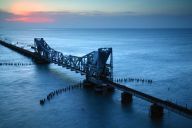 Pamban Rail Bridge
Pamban Rail Bridge Pamban Road Bridge
Pamban Road Bridge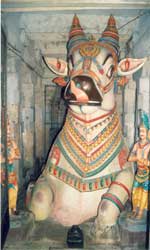 Nandi
Nandi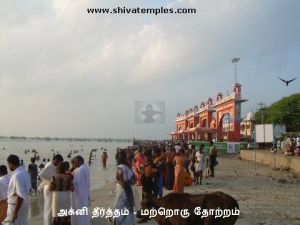 Sea shore - Agni Theertham
Sea shore - Agni Theertham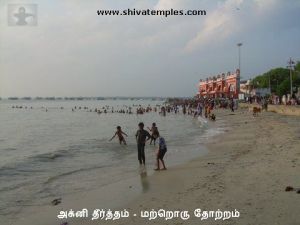 Agni Theeertham - Another View
Agni Theeertham - Another View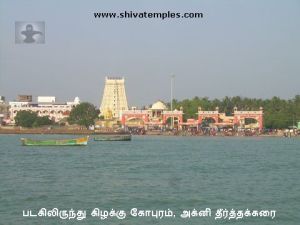 View of gopuram and agni theertham shore from the sea
View of gopuram and agni theertham shore from the sea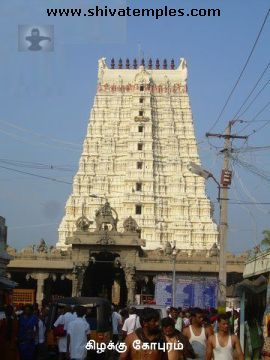 Eastern Gopuram
Eastern Gopuram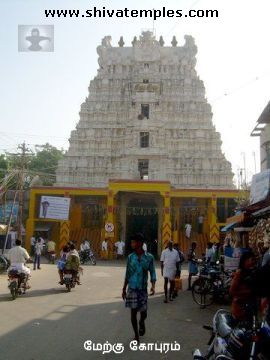 Western Gopuram
Western Gopuram